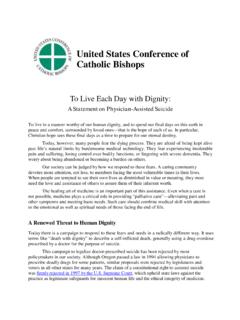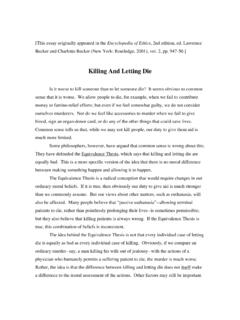Transcription of Assisted Suicide and Euthanasia: Beyond Terminal …
1 Assisted Suicide and euthanasia : Beyond Terminal illness Advocates for physician- Assisted Suicide and euthanasia often claim these practices will only affect a narrow class of terminally ill patients who are expected to die soon in any case. But there is ample evidence of a slippery slope toward ending the lives of patients with chronic illnesses or disabilities, or even those who are vulnerable or marginalized in other ways. Swiss Group Will Euthanize Those Who Feel Old'. In Switzerland, the association Exit (which has 70,000 members and is one of the biggest euthanasia organisations in the world) has voted to include Suicide because of old age' on its statute . Swiss law allows organisations that provide euthanasia services to establish their own internal rules, which may vary from clinic to clinic.
2 The decision of Exit's board has been criticised by the Swiss medical association, which fears that such a move could encourage Suicide among the elderly.. I. Abbadessa , euthanasia Group Votes to Extend Suicide Choice to Those Who Feel Old', West, June 2, 2014, **. euthanasia for Psychiatric Patients in Belgium Canada Next? Belgium legalized euthanasia and Assisted Suicide in 2002 for unbearable or untreatable suffering, and this is interpreted to cover suffering from psychological conditions. Among the patients receiving lethal drugs are those with depression, personality disorders, and Asperger's syndrome. Says one commentary: Opponents of the law argued during its deliberation that the primary purpose of psychiatric care should be the prevention of Suicide , but the opposing argument that the suffering of psychiatric patients is as unbearable' as the suffering of patients with other medical conditions prevailed.
3 Now that Canada's highest court has defined a right . to euthanasia , supporters are pressing for the same expansion there. N. Melville, Assisted Suicide for Mental illness Gaining Ground, Medscape Medical News, July 31, 2015, ; W. Smith, Canada Push To Allow Mentally Ill euthanasia , National Review Online, April 18, 2017, **. The Dutch Slippery Slope Since the 1970s a series of court decisions has established that Dutch doctors need not fear punishment for taking their patients' lives or assisting their suicides if they follow certain 2. guidelines. The guidelines state, among other things, that the patient must have intolerable pain for which there seems to be no other solution. But Dutch practice has become much broader.
4 On a landmark court ruling in 1986: The patient in this case was not Terminal , nor was she in acute physical pain. The court ruled, nevertheless, that psychic suffering' or the potential disfigurement of personality' could be acceptable grounds for requesting euthanasia .. C. Gomez, Regulating Death: euthanasia and the Case of the Netherlands (The Free Press 1991) at 39. **. According to judicial guidance in the 1990s, later formalized at the University Medical Center in Groningen ( Groningen protocol ), physicians may give lethal injections to newborn infants with disabilities (most commonly spina bifida). Of 22 such cases analyzed by Groningen physicians, 59% of the infants had a long life expectancy and this was counted in favor of euthanasia , as it meant a longer period of suffering and dependence on medical care.
5 E. Verhagen et al., The Groningen Protocol euthanasia in Severely Ill Newborns, New England Journal of Medicine 959-62 (March 10, 2005) at 960, Table 1. **. A Dutch End-of-Life Clinic, established by a pro- euthanasia group in 2012, provides euthanasia for patients whose regular physicians deny their request, including cases of a psychiatric or psychological condition, dementia, or being tired of living.. M. Snijdewind et al., A Study of the First Year of the End-of-Life Clinic for Physician- Assisted Dying in the Netherlands, JAMA Internal Medicine 1633-40 (2015) at 1633, **. Dr. Boudewijn Chabot, who forced the issue of Assisted Suicide for psychiatric patients in the Netherlands by giving a lethal dose to a physically healthy woman in 1991, now says the euthanasia practice is running amok in his country.
6 Chabot, who has been called the Grand Old Man of Dutch euthanasia , says the legal requirements that a patient have unbearable and irreversible suffering and no reasonable alternative to euthanasia have become meaningless, as a patient's claim about them is simply accepted as fact. euthanasia is also increasingly provided by an End of Life Clinic that specializes in euthanasia and provides no alternatives. Chabot notes that in ten years, euthanasia cases have grown from two thousand to six thousand a year;. since 2009, euthanasia for patients with dementia has increased from 12 to 141, and for chronic psychiatric patients from 0 to 60, calling into question the remaining requirement for a voluntary and deliberate request from the patient.
7 M. Cook, A Dutch euthanasia pioneer surveys the wreckage and despairs, BioEdge, 24 June 2017, ;. B. Chabot, Worrisome Culture Shift in the Context of Self-Selected Death, NRC Handelsblad, June 16, 2017 (English translation with link to original), euthanasia -genie-is-out-of-the-bottle-by -boudewijn-chabot-translation/. 3. The Difficulties of a Terminal Prognosis Under Oregon law, a request for physician- Assisted Suicide is valid only if two physicians state that the patient has a Terminal disease that is incurable and irreversible and will, within reasonable medical judgment, produce death within six months. Ore. Rev. Stat. (12). Yet the actual time from Terminal diagnosis and request for lethal drugs, to the patient's death, has ranged from 14 days to 1,009 days (over two-and-a-half years).
8 Of 143 patients in Oregon who died from the prescribed drugs in 2017, fourteen were diagnosed as having less than six months to live in previous years and given the lethal prescription. This is true of nineteen patients in 2016, seven in 2015 and eleven in 2014. Oregon Health Authority, Oregon Death with Dignity Act, DIGNITYACT/ **. Patients predicted to have less than six months to live may survive for years. Of the 90 patients who received lethal prescriptions in Oregon in 2016 but did not take the drugs, only 36 died the same year of other causes. In one national study, among 900 patients found eligible for hospice care because they were expected to die in less than six months, 70% lived longer. Id. at 5; N.
9 Shapiro, Terminal Uncertainty, in Seattle Weekly, January 14, 2009, **. In 2018 a Swedish investigator found that the Oregon Health Authority has always interpreted Terminal to include conditions that can be reversed or even cured, but will likely lead to death in six months if not treated. If treatment is refused by the patient, or withheld by others such as a physician, insurance company or government agency, that makes the treatable condition Terminal and the lethal drugs can be prescribed. This expands the definition of Terminal to cover patients who could have lived for decades with treatment. F. Stahle, Oregon Health Authority Reveals Hidden Problems with the Oregon Assisted Suicide Model, . January 2018, at **.
10 Says Dr. Leslie Blackhall, section head of palliative care at the University of Virginia Medical School: Predicting how long someone has to live is very imprecise in most conditions that people die of in the United States, where most people die of cancer, heart disease, lung disease (like emphysema), and dementia. The first three conditions cited by Dr. Blackwell make up 87% of the cases that qualified patients for lethal drugs under the Oregon law in 2016. See: F. Lowry, Do Patients Need to Know They Are Terminally Ill? , Medscape Medical News, May 2, 2013, ; Oregon Public Health Division, op. cit. at 9. **. 4. From the authors of the United States' most extensive study of prognosis and treatment in Terminal illness : Deciding who should be counted terminally ill' will pose such severe difficulties that it seems untenable as a criterion for permitting physician- Assisted Suicide .














